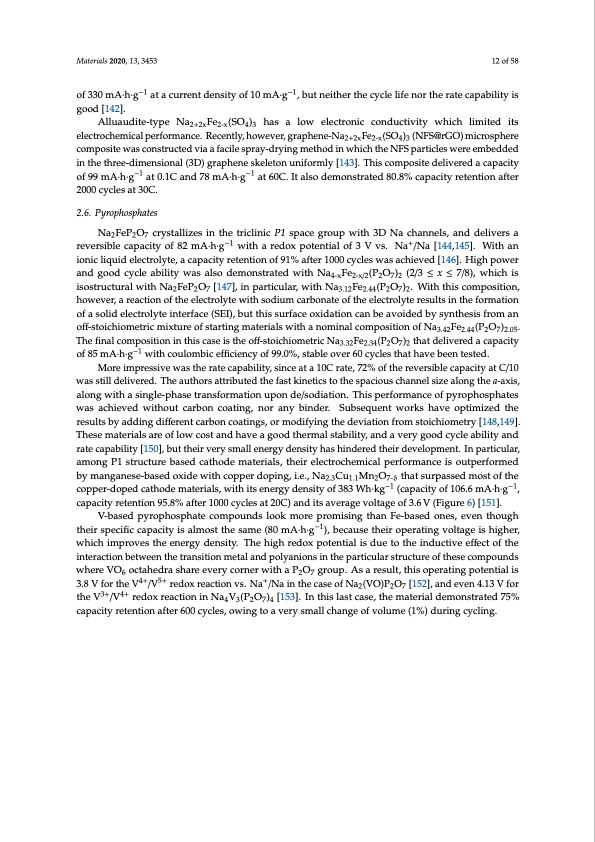
PDF Publication Title:
Text from PDF Page: 012
Materials 2020, 13, 3453 12 of 58 of 330 mA·h·g−1 at a current density of 10 mA·g−1, but neither the cycle life nor the rate capability is good [142]. Alluaudite-type Na2+2x Fe2-x (SO4 )3 has a low electronic conductivity which limited its electrochemical performance. Recently, however, graphene-Na2+2xFe2-x(SO4)3 (NFS@rGO) microsphere composite was constructed via a facile spray-drying method in which the NFS particles were embedded in the three-dimensional (3D) graphene skeleton uniformly [143]. This composite delivered a capacity of 99 mA·h·g−1 at 0.1C and 78 mA·h·g−1 at 60C. It also demonstrated 80.8% capacity retention after 2000 cycles at 30C. 2.6. Pyrophosphates Na2FeP2O7 crystallizes in the triclinic P1 space group with 3D Na channels, and delivers a reversible capacity of 82 mA·h·g−1 with a redox potential of 3 V vs. Na+/Na [144,145]. With an ionic liquid electrolyte, a capacity retention of 91% after 1000 cycles was achieved [146]. High power and good cycle ability was also demonstrated with Na4-xFe2-x/2(P2O7)2 (2/3 ≤ x ≤ 7/8), which is isostructural with Na2FeP2O7 [147], in particular, with Na3.12Fe2.44(P2O7)2. With this composition, however, a reaction of the electrolyte with sodium carbonate of the electrolyte results in the formation of a solid electrolyte interface (SEI), but this surface oxidation can be avoided by synthesis from an off-stoichiometric mixture of starting materials with a nominal composition of Na3.42Fe2.44(P2O7)2.05. The final composition in this case is the off-stoichiometric Na3.32Fe2.34(P2O7)2 that delivered a capacity of 85 mA·h·g−1 with coulombic efficiency of 99.0%, stable over 60 cycles that have been tested. More impressive was the rate capability, since at a 10C rate, 72% of the reversible capacity at C/10 was still delivered. The authors attributed the fast kinetics to the spacious channel size along the a-axis, along with a single-phase transformation upon de/sodiation. This performance of pyrophosphates was achieved without carbon coating, nor any binder. Subsequent works have optimized the results by adding different carbon coatings, or modifying the deviation from stoichiometry [148,149]. These materials are of low cost and have a good thermal stability, and a very good cycle ability and rate capability [150], but their very small energy density has hindered their development. In particular, among P1 structure based cathode materials, their electrochemical performance is outperformed by manganese-based oxide with copper doping, i.e., Na2.3Cu1.1Mn2O7-δ that surpassed most of the copper-doped cathode materials, with its energy density of 383 Wh·kg−1 (capacity of 106.6 mA·h·g−1, capacity retention 95.8% after 1000 cycles at 20C) and its average voltage of 3.6 V (Figure 6) [151]. V-based pyrophosphate compounds look more promising than Fe-based ones, even though their specific capacity is almost the same (80 mA·h·g−1), because their operating voltage is higher, which improves the energy density. The high redox potential is due to the inductive effect of the interaction between the transition metal and polyanions in the particular structure of these compounds where VO6 octahedra share every corner with a P2O7 group. As a result, this operating potential is 3.8 V for the V4+/V5+ redox reaction vs. Na+/Na in the case of Na2(VO)P2O7 [152], and even 4.13 V for the V3+/V4+ redox reaction in Na4V3(P2O7)4 [153]. In this last case, the material demonstrated 75% capacity retention after 600 cycles, owing to a very small change of volume (1%) during cycling.PDF Image | Electrode Materials for Sodium-Ion Batteries

PDF Search Title:
Electrode Materials for Sodium-Ion BatteriesOriginal File Name Searched:
materials-13-03453-v2.pdfDIY PDF Search: Google It | Yahoo | Bing
Salgenx Redox Flow Battery Technology: Salt water flow battery technology with low cost and great energy density that can be used for power storage and thermal storage. Let us de-risk your production using our license. Our aqueous flow battery is less cost than Tesla Megapack and available faster. Redox flow battery. No membrane needed like with Vanadium, or Bromine. Salgenx flow battery
| CONTACT TEL: 608-238-6001 Email: greg@salgenx.com | RSS | AMP |